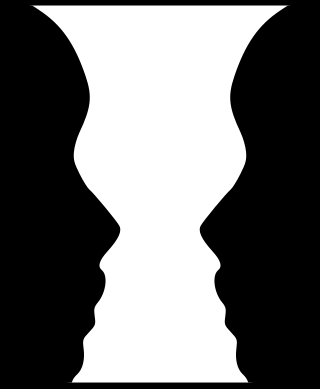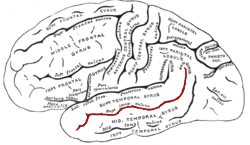
Perception is the organization, identification, and interpretation of sensory information in order to represent and understand the presented information or environment. All perception involves signals that go through the nervous system, which in turn result from physical or chemical stimulation of the sensory system. Vision involves light striking the retina of the eye; smell is mediated by odor molecules; and hearing involves pressure waves.
An illusion is a distortion of the senses, which can reveal how the mind normally organizes and interprets sensory stimulation. Although illusions distort the human perception of reality, they are generally shared by most people.

Within visual perception, an optical illusion is an illusion caused by the visual system and characterized by a visual percept that arguably appears to differ from reality. Illusions come in a wide variety; their categorization is difficult because the underlying cause is often not clear but a classification proposed by Richard Gregory is useful as an orientation. According to that, there are three main classes: physical, physiological, and cognitive illusions, and in each class there are four kinds: Ambiguities, distortions, paradoxes, and fictions. A classical example for a physical distortion would be the apparent bending of a stick half immerged in water; an example for a physiological paradox is the motion aftereffect. An example for a physiological fiction is an afterimage. Three typical cognitive distortions are the Ponzo, Poggendorff, and Müller-Lyer illusion. Physical illusions are caused by the physical environment, e.g. by the optical properties of water. Physiological illusions arise in the eye or the visual pathway, e.g. from the effects of excessive stimulation of a specific receptor type. Cognitive visual illusions are the result of unconscious inferences and are perhaps those most widely known.
Auditory illusions are false perceptions of a real sound or outside stimulus. These false perceptions are the equivalent of an optical illusion: the listener hears either sounds which are not present in the stimulus, or sounds that should not be possible given the circumstance on how they were created.

The Müller-Lyer illusion is an optical illusion consisting of three stylized arrows. When viewers are asked to place a mark on the figure at the midpoint, they tend to place it more towards the "tail" end. The illusion was devised by Franz Carl Müller-Lyer (1857–1916), a German sociologist, in 1889.
The McGurk effect is a perceptual phenomenon that demonstrates an interaction between hearing and vision in speech perception. The illusion occurs when the auditory component of one sound is paired with the visual component of another sound, leading to the perception of a third sound. The visual information a person gets from seeing a person speak changes the way they hear the sound. If a person is getting poor quality auditory information but good quality visual information, they may be more likely to experience the McGurk effect. Integration abilities for audio and visual information may also influence whether a person will experience the effect. People who are better at sensory integration have been shown to be more susceptible to the effect. Many people are affected differently by the McGurk effect based on many factors, including brain damage and other disorders.
A mental image is an experience that, on most occasions, significantly resembles the experience of 'perceiving' some object, event, or scene, but occurs when the relevant object, event, or scene is not actually present to the senses. There are sometimes episodes, particularly on falling asleep and waking up, when the mental imagery may be dynamic, phantasmagoric and involuntary in character, repeatedly presenting identifiable objects or actions, spilling over from waking events, or defying perception, presenting a kaleidoscopic field, in which no distinct object can be discerned. Mental imagery can sometimes produce the same effects as would be produced by the behavior or experience imagined.

Figure–ground organization is a type of perceptual grouping that is a vital necessity for recognizing objects through vision. In Gestalt psychology it is known as identifying a figure from the background. For example, black words on a printed paper are seen as the "figure", and the white sheet as the "background".
Multisensory integration, also known as multimodal integration, is the study of how information from the different sensory modalities may be integrated by the nervous system. A coherent representation of objects combining modalities enables animals to have meaningful perceptual experiences. Indeed, multisensory integration is central to adaptive behavior because it allows animals to perceive a world of coherent perceptual entities. Multisensory integration also deals with how different sensory modalities interact with one another and alter each other's processing.

Language processing refers to the way humans use words to communicate ideas and feelings, and how such communications are processed and understood. Language processing is considered to be a uniquely human ability that is not produced with the same grammatical understanding or systematicity in even human's closest primate relatives.
The two-streams hypothesis is a model of the neural processing of vision as well as hearing. The hypothesis, given its initial characterisation in a paper by David Milner and Melvyn A. Goodale in 1992, argues that humans possess two distinct visual systems. Recently there seems to be evidence of two distinct auditory systems as well. As visual information exits the occipital lobe, and as sound leaves the phonological network, it follows two main pathways, or "streams". The ventral stream leads to the temporal lobe, which is involved with object and visual identification and recognition. The dorsal stream leads to the parietal lobe, which is involved with processing the object's spatial location relative to the viewer and with speech repetition.
Speech perception is the process by which the sounds of language are heard, interpreted, and understood. The study of speech perception is closely linked to the fields of phonology and phonetics in linguistics and cognitive psychology and perception in psychology. Research in speech perception seeks to understand how human listeners recognize speech sounds and use this information to understand spoken language. Speech perception research has applications in building computer systems that can recognize speech, in improving speech recognition for hearing- and language-impaired listeners, and in foreign-language teaching.
The study of time perception or chronoception is a field within psychology, cognitive linguistics and neuroscience that refers to the subjective experience, or sense, of time, which is measured by someone's own perception of the duration of the indefinite and unfolding of events. The perceived time interval between two successive events is referred to as perceived duration. Though directly experiencing or understanding another person's perception of time is not possible, perception can be objectively studied and inferred through a number of scientific experiments. Some temporal illusions help to expose the underlying neural mechanisms of time perception.
The cutaneous rabbit illusion is a tactile illusion evoked by tapping two or more separate regions of the skin in rapid succession. The illusion is most readily evoked on regions of the body surface that have relatively poor spatial acuity, such as the forearm. A rapid sequence of taps delivered first near the wrist and then near the elbow creates the sensation of sequential taps hopping up the arm from the wrist towards the elbow, although no physical stimulus was applied between the two actual stimulus locations. Similarly, stimuli delivered first near the elbow then near the wrist evoke the illusory perception of taps hopping from elbow towards wrist. The illusion was discovered by Frank Geldard and Carl Sherrick of Princeton University, in the early 1970s, and further characterized by Geldard (1982) and in many subsequent studies. Geldard and Sherrick likened the perception to that of a rabbit hopping along the skin, giving the phenomenon its name. While the rabbit illusion has been most extensively studied in the tactile domain, analogous sensory saltation illusions have been observed in audition and vision. The word "saltation" refers to the leaping or jumping nature of the percept.

The superior temporal sulcus (STS) is the sulcus separating the superior temporal gyrus from the middle temporal gyrus in the temporal lobe of the brain. A sulcus is a deep groove that curves into the largest part of the brain, the cerebrum, and a gyrus is a ridge that curves outward of the cerebrum.
The neuroscience of music is the scientific study of brain-based mechanisms involved in the cognitive processes underlying music. These behaviours include music listening, performing, composing, reading, writing, and ancillary activities. It also is increasingly concerned with the brain basis for musical aesthetics and musical emotion. Scientists working in this field may have training in cognitive neuroscience, neurology, neuroanatomy, psychology, music theory, computer science, and other relevant fields.

In psychology, visual capture is the dominance of vision over other sense modalities in creating a percept. In this process, the visual senses influence the other parts of the somatosensory system, to result in a perceived environment that is not congruent with the actual stimuli. Through this phenomenon, the visual system is able to disregard what other information a different sensory system is conveying, and provide a logical explanation for whatever output the environment provides. Visual capture allows one to interpret the location of sound as well as the sensation of touch without actually relying on those stimuli but rather creating an output that allows the individual to perceive a coherent environment.
Change deafness is a perceptual phenomenon that occurs when, under certain circumstances, a physical change in an auditory stimulus goes unnoticed by the listener. There is uncertainty regarding the mechanisms by which changes to auditory stimuli go undetected, though scientific research has been done to determine the levels of processing at which these consciously undetected auditory changes are actually encoded. An understanding of the mechanisms underlying change deafness could offer insight on issues such as the completeness of our representation of the auditory environment, the limitations of the auditory perceptual system, and the relationship between the auditory system and memory. The phenomenon of change deafness is thought to be related to the interactions between high and low level processes that produce conscious experiences of auditory soundscapes.
Chronostasis is a type of temporal illusion in which the first impression following the introduction of a new event or task-demand to the brain can appear to be extended in time. For example, chronostasis temporarily occurs when fixating on a target stimulus, immediately following a saccade. This elicits an overestimation in the temporal duration for which that target stimulus was perceived. This effect can extend apparent durations by up to half a second and is consistent with the idea that the visual system models events prior to perception.
Multistable auditory perception is a cognitive phenomenon in which certain auditory stimuli can be perceived in multiple ways. While multistable perception has been most commonly studied in the visual domain, it also has been observed in the auditory and olfactory modalities. In the olfactory domain, different scents are piped to the two nostrils, while in the auditory domain, researchers often examine the effects of binaural sequences of pure tones. Generally speaking, multistable perception has three main characteristics: exclusivity, implying that the multiple perceptions cannot simultaneously occur; randomness, indicating that the duration of perceptual phases follows a random law, and inevitability, meaning that subjects are unable to completely block out one percept indefinitely.










